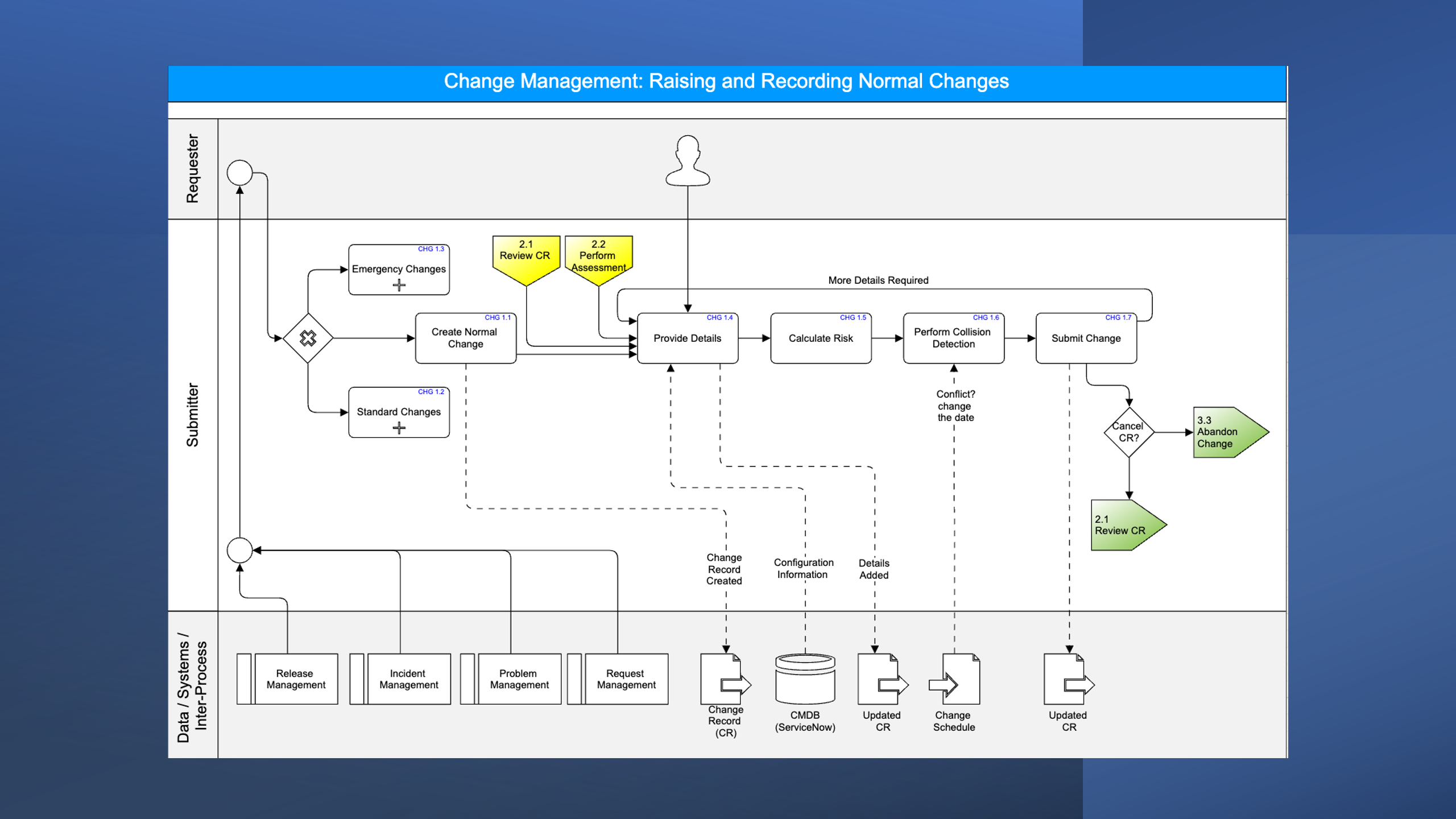Change Management Best Practices
We're pleased to provide this comprehensive guide to Change Management Process best practices. Whether you want to enhance your existing Change process or create a new one, this guide has you covered!
Navvia is excited to provide the second best practice guide in our series of the five foundational ITSM processes every organization needs to have in place.
For each process, we provide a process description, key benefits, roles, responsibilities, a description of the significant activities, tips on process governance, and some design and implementation guidance.
Change Management Description
The Change Management process is responsible for effectively managing all modifications to the IT infrastructure or applications, starting from the initial request for the change through to its Implementation.
To ensure successful Change Management, it is crucial for the process to record and authorize all changes at the appropriate levels within both IT and the Business without creating unnecessary bureaucracy.
While simple, routine, and standard changes may require minimal authorization, these changes must go through the process to ensure accurate recording and appropriate testing.
On the other hand, complex and high-impact changes may need to be authorized at the Business Executive and IT Executive levels before implementation can begin.
Change Management includes all the activities and tasks required to:
- Raise and record changes
- Assess and evaluate changes
- Authorize and schedule changes
- Coordinate, build, test, and implement changes
- Review and close changes
The Change Management process may also include separate activities to handle:
- Standard changes
- Emergency changes
Change Management is a dynamic and ever-evolving process that demands constant vigilance and enhancement to ensure its continued effectiveness for the organization.
By adhering to industry best practices and implementing a clearly defined Change Management process, businesses can reduce risk, effectively improve their security posture, and minimize the disruptions caused by changes, thereby upholding strong customer satisfaction with their IT services.
Change Management Benefits
ITSM (IT Service Management) Change Management offers several benefits:
- Improved Service Availability: Change Management helps ensure that changes to IT services are planned and implemented effectively, reducing the risk of service disruptions or outages. This results in increased service availability and reliability.
- Minimized Risks: By following a structured Change Management process, IT organizations can mitigate key risks such as security vulnerabilities, system downtime, and non-compliance with regulations. This minimizes the overall impact of changes on the IT environment.
- Enhanced Efficiency: Change Management promotes standardized processes for requesting, approving, and implementing changes. This standardization improves efficiency by reducing duplicate efforts, streamlining workflows, and eliminating unnecessary delays.
- Increased Accountability: Change Management provides clear roles and responsibilities for managing and approving changes. This helps establish accountability within the organization and ensures that changes are thoroughly reviewed and authorized before implementation.
- Improved Communication and Collaboration: Effective Change Management facilitates better communication and collaboration between different teams within an organization. It enables cross-functional coordination and ensures that relevant stakeholders are informed about upcoming changes.
These benefits contribute to the overall stability, reliability, and efficiency of IT services within an organization.
Change Management and Cyber Security
Change Management is a vital component of cybersecurity that ensures secure and efficient handling of changes within an organization's IT environment.
Adopting a formal Change Management process can significantly reduce the risks associated with system updates, software upgrades, and infrastructure modifications, thereby enhancing cybersecurity.
This structured approach allows teams to assess potential security impacts before implementing changes, reducing the likelihood of introducing vulnerabilities or disruptions.
Furthermore, effective Change Management enhances accountability and communication, ensuring that all stakeholders, including security teams, are informed and aligned during the change process.
By documenting and analyzing changes, organizations can maintain a comprehensive audit trail, which is crucial for compliance and risk management.
Ultimately, robust Change Management practices not only bolster an organization's security posture but also improve operational efficiency and stability, making them indispensable aspects of cybersecurity strategy.
Read our post on Boosting Cyber Resilience with IT Security Assessments and ITSM Processes for more information on improving your cyber security posture.
Change Management Roles and Responsibilities
Here is a summary of the typical Change Management process roles. It is important to note that these roles do not indicate any hierarchical status within the organization, and their responsibilities are limited to that particular process.
Having clearly defined roles and responsibilities is crucial for the efficient execution of any process. This clarity helps ensure that everyone is on the same page and clearly understands their place in the process.
Here are some typical roles for the Incident Management process.
Change Management Process Owner
A Senior Manager responsible for ensuring that all departments within the IT organization implement and use the process effectively.
Their specific tasks include:
- Defining the process's mission.
- Communicating process goals and objectives to all stakeholders.
- Resolving any cross-functional issues.
- Ensuring consistent execution across departments.
- Reporting on process effectiveness to senior management.
- Initiating process improvements as necessary.
Change Manager
The Change Manager is in charge of overseeing the daily implementation of the Change Managment process. The Change Manager works closely with the Process Owner to ensure that the process is executed uniformly throughout the organization.
Their general Change Management duties include:
- Managing the process's daily tasks.
- Collecting and presenting process metrics.
- Monitoring compliance with the process.
- Reporting any process-related issues.
- Chairing process meetings.
Their process specific Change Management duties may include:
- Authorizing the Change Request
- Convening & chairing Change Advisory Board (CAB) meetings
- Ensuring that the Forward Schedule of Changes (FSC) is current and available
- Conducting post-implementation reviews (PIRs)
- Authorizing Change Process Models
- Approving and maintaining Standard Change Templates
- Determining Emergency Change types
Change Coordinator
In large organizations where there are many changes happening, the role of Change Manager may be split among several change coordinators. This distribution is often based on factors such as the type of change, the department, or the business application involved. Change coordinators play a vital role in the Change Management process and have many responsibilities, including:
- Reviewing Change Requests (CRs) to determine whether they should be approved based on their value to the business, the potential risks involved, and the expected benefits.
- Conducting a thorough risk and impact assessment of submitted Change Requests, and seeking additional information if necessary.
- Identifying and creating any additional tasks that go beyond those initially identified by the requester.
- Coordinating the activities related to building, testing, and deploying the change, as appropriate.
- Participating in the Change review before its closure and providing expert input during Change Advisory Board (CAB) meetings, as needed.
Having change coordinators involved ensures that the Change Management process is executed smoothly and efficiently, even in organizations with complex change management needs.
Requester / Submitter
The individual initiating the change, whether it be a customer or user from the business side or someone from the IT department. It could also be the person directly requesting the change.
The individual making the request is responsible for the following:
- Initiating the Change to start the process.
- Specifying the business needs, goals and objectives of the Change.
- Providing additional information for the Change as requested throughout the process.
- Setting the "priority" based on predefined parameters.
- Confirming the successful completion of the Change to enable closure.
In some cases, the person submitting the change are doing so in behalf of someone else. Some ITSM tools allow you to distinguish between the person requesting the change and the person submitting the change.
Change Approver
The Change Approver holds the responsibility of assessing the Change to determine whether it is ready for implementation. The Change Approver is typically a manager with responsibility for the infrastructure component or application being modified. Some high risk changes may require multiple levels of approval.
- Evaluating the potential risks associated with implementing or not implementing against the expected scope and benefits
- Assessing the suitability of the remediation plan
- Ensuring the completeness of implementation details
- Reviewing the scheduled tasks for various Change tasks.
The Change Approver may grant approval, reject the Change as not feasible, or request further information and clarification before making a decision.
Change Implementer
Responsible for executing the Change tasks to which they have been assigned. Upon completion, they must update the task with appropriate information and select closure code and/or status. There may be multiple people involved in the implementation for a given Request for Change (RFC) (each assigned their own tasks).
This role may also be referred to as release packaging or deployment practitioner. Responsibilities of this role include the building, testing and physical deployment tasks associated with approved Changes that may be assigned to multiple individuals.
Change Advisory Board (CAB)
The Change Advisory Board (CAB) is a group of individuals responsible for assessing and overseeing changes to the IT environment within an organization. Their primary role is to provide guidance and support to the change management teams in evaluating and prioritizing requested changes.
The CAB plays a crucial role in ensuring that changes are carefully reviewed and approved before implementation. They help to assess the potential impact of proposed changes on various aspects of the organization, such as operations, infrastructure, security, and customer experience. By offering their expertise and oversight, the CAB helps minimize risks associated with changes and ensures smooth transitions.
The CAB acts as a bridge between the technical teams implementing changes and the business stakeholders who are impacted by these changes. Their role is critical in maintaining the stability, security, and efficiency of the IT environment while facilitating continuous improvement.
A subset of the CAB is the Emergency Change Advisory Board (ECAB). The ECAB specifically focuses on urgent changes that need immediate attention to resolve an urgent issue.
Change Management Activities

Here at Navvia, we strongly believe in simplifying complex processes by breaking them into high-level activities.
These activities serve as a guide, outlining the crucial steps in the process and the connections between them. We then map out the detailed tasks required to complete each activity. Organizing processes in this way makes understanding and communicating the process easier.
The following are the critical activities of the Change Management Process.
Raising and Recording Normal Changes
During this activity, the Change record is created and all necessary information is captured. Once the information has all been captured, the Change record is submitted for review, assessment, authorization, scheduling, and implementation (the next activities).
Change Models can be used to determine what information is required based on the change type.
Assessing and Evaluating Changes
During this activity, the Change Manager or Coordinator carefully analyzes the submitted Change record, evaluating its details, potential impact, feasibility, and alignment with strategic goals.
They also review the remediation plan and scheduled tasks, collaborating with stakeholders for input. This comprehensive review ensures that all relevant details are addressed before proceeding, contributing to the success and efficiency of implementing changes.
Authorize & Schedule the Change
This is where all necessary approvals must be obtained for the Change to proceed. This crucial step ensures that all stakeholders have reviewed and agreed upon the proposed change, considering any potential risks and benefits.
The approval process involves evaluating the potential impact of the change on various aspects of the organization, such as operations, infrastructure, security, and customer experience. It also involves assessing the suitability of the remediation plan and reviewing the scheduled tasks for the change.
Once the necessary approvals have been obtained, the Change can be scheduled for implementation.
Coordinate Build, Test and Implement
After obtaining necessary approvals and testing acknowledgements from Release Management, the Change Coordinator or designated team carries out the approved implementation tasks.
They coordinate the building, testing, and implementation of the Change according to established procedures and best practices. During implementation, the Change Coordinator ensures tasks are performed as planned and verifies the proper functioning of related systems and components.
In case of unforeseen issues, the Change Coordinator collaborates with the Release Management team to implement remediation measures and restore the system or application to its original state. This controlled approach minimizes disruptions and maximizes the success of the Change Management process.
Review and Close the Change
Once the Change has been implemented and all necessary tasks have been completed, it is essential to review and close the Change record.
During the review process, the Change Manager or Change Coordinator will assess the effectiveness of the Change and determine whether it has met its intended objectives. This evaluation helps to identify any areas for improvement and provides valuable insights for future Change management efforts.
If the Change has achieved the desired outcomes and has not caused any negative impacts, the Change record can be officially closed. This involves updating the status of the Change in the Change management system and ensuring that all relevant stakeholders are informed of the closure.
Closing the Change record also involves documenting any lessons learned or best practices that can be applied to future Change initiatives. This knowledge sharing helps to enhance the overall Change management process and ensures continuous improvement.
In some cases, additional steps may be required before closing the Change record. For example, if the Change has resulted in unexpected issues or if there are outstanding tasks or follow-up actions that need to be addressed, these must be resolved before the Change can be officially closed.
Standard Changes
Some changes may be categorized as "standard" changes, which are routine and low-risk modifications that do not require additional approvals or lengthy review processes.
These changes follow predefined guidelines and best practices to ensure consistency and minimize potential risks.
By implementing standard changes, organizations can expedite the process for routine modifications and focus resources on more critical changes.
Although they do not require additional approvals, standard changes still undergo monitoring and evaluation to ensure successful implementation.
Standard Changes allows organizations to balance efficiency and risk management while maintaining the stability and integrity of their IT environment.
Emergency Changes
Emergency Changes are intended to handle urgent high-impact situations where approval and implementation steps need to be accelerated to restore services.
Once confirmed as an Emergency Change Request, the Change Coordinator collaborates closely with stakeholders, including the Emergency Change Advisory Board (ECAB) to expedite approval and implementation.
Its important to note that the Emergency Change path should be used for true emergencies and not as a way to circumvent the standard process.
Change Management Process Governance
Process governance is an essential aspect of the Incident Management process. It involves establishing a framework to ensure an organization effectively manages and executes the process.
The Change Management process owner plays a critical role in process governance, defining the process's mission and communicating its goals and objectives to all stakeholders. They also resolve cross-functional issues and initiate improvements to enhance the process's effectiveness.
The Change Manager oversees the daily implementation of the process, ensuring uniform execution throughout the organization. They collect and present process metrics, monitor compliance and report process-related issues.
Working as a team, the process owner, process manager, and other stakeholders should periodically assess the process looking for gaps and potential areas of improvement. One way to do this is through a formal process assessment. Learm more about assessments by reading The Importance of a Process Maturity Assessment.
Through process governance, organizations can maintain consistency, efficiency, and continuous improvement in their Incident Management practices.
Change Management Process Design and Implementation
Believe it or not, implementing an ITSM process is more complex than just installing an ITSM tool. It requires a well-defined process to ensure a successful implementation. To help organizations navigate this process, we recommend following these five steps:
- Identify gaps in your current process and supporting tools: Before implementing a new process, it's important to assess your existing process and tools to identify any areas that may need improvement. This review should include outdated documentation, gaps in ITSM tool functionality, or lack of integration between different systems.
- Collaborate with stakeholders to understand their process requirements: Involving all relevant stakeholders in the implementation process is crucial. These stakeholders include not only the information technology team but also all business stakeholders. By engaging with stakeholders early on, you can gather their input and ensure that their requirements are included in the design and implementation of the Change Management process.
- Define and document your Change Management process: Once you have identified the gaps and gathered input from stakeholders, it's time to define and document your Change Management process. This task involves clearly defining the steps and activities involved in managing changes, as well as establishing roles and responsibilities. It's important to align the process with industry best practices, such as ITIL (Information Technology Infrastructure Library), COBIT, or ISO20000 to ensure consistency and efficiency.
- Capture user stories and requirements to guide the developer or implementer: To effectively implement the Change Management process in the ITSM tool, capturing user stories and requirements is crucial. This activity involves understanding end-users specific needs and expectations and translating them into actionable tasks for the developer or implementer, ensuring the tool meets user needs.
- Ensure sustainability by providing ITSM training, defining controls, reporting metrics, and implementing governance: To ensure long-term success, provide Change Management training to users and Information Technology organization staff. In addition, define controls for process governance, track performance with metrics, and implement continuous monitoring and improvement.
By following these five steps, organizations can ensure a successful implementation of the Change Management Process and supporting ITSM tools.
Additional Resources
Here are links to additional resources to
- Webinar: Leading a Successful ITSM Tool Implementation
- Webinar: Best Practices in Process Design and Documentation
- Blog: An Introduction to Process Mapping
- Blog: Process Documentation: A Complete Guide
- Blog: Building the Business Case for ITSM Brest Practices
The Change Management process is a crucial aspect of any organization's IT infrastructure. By following a structured change approach organizations can maintain stability, security, and efficiency while facilitating continuous improvement.


